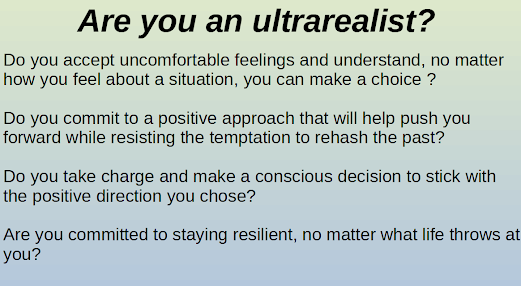It seems like every five years I get an injury that “interferes” with my running. I do not handle recovery well and several times I have prematurely returned to running which resulted in re-injuring myself. I simply refused to accept the reality of my situation.
Some Examples of Ultrarealists:
Jamie Whitmore (from pro-athlete to paralympian)
Geoffrey Kamworor (from a fall at the start of a race to winning the race)
Gabe Grunewald (from track star to rare cancer advocate )
Barriers to Accepting Reality:
Fear and laziness – Turning away from the uncomfortable, scary or daunting realities. You must be able to call bullshit on yourself and ask yourself, “What the hell am I doing? What are my options? What choice, no matter how difficult, reflects my values?”
Cognitive bias – Our brains establish beliefs on limited information, and having formed these beliefs, become resistant to changing them. You must be able to ask yourself, “I know I have heard that before, but is it true? Accurate? How do I know?”
Ego defense – Thoughts of not being “enough” are a result of judging yourself by the world’s standards. The reality is that you can’t control what the world thinks, you only control what you think. Replace self-doubts with self-criticism, judging yourself by your own standards and asking, “Is this what the world thinks or what I think?”
2. EMBRACE the situation – Embracing the reality of a bad situation entails committing to making the best of it.
Three Steps in “making lemonade from lemons”:
1. Internal locus of control – You have the capacity to achieve your goals by your own initiative. Focus on what you can control. Censor self-limiting thoughts. Pivot from problem to solution. Don’t think in all-or-nothing terms. Ask for help, you don’t have to go it alone.
2. Growth mindset – People with a growth mindset believe that through hard work they can increase not just their knowledge or skill, but also their underlying ability. They readily embrace challenges. Challenges you experience are steps in your life journey, embrace them, and make the best of them. Just do the work. It doesn’t all have to happen today. Sometimes you might need to just check the box and move on.
3. Gratitude – Every experience has layers and facets, and they’re never truly all bad simultaneously. By focusing on the “silver lining” of an overall bad situation helps you to embrace it. Make a regular practice of listing things you are grateful for. As you move through your day, give thanks for all the people, places, and things you experience. Gratitude works, not by transforming reality itself, but how reality is seen.
3. ADDRESS the situation – Addressing the reality of a bad situation means making the best of it.
Three Things Needed to Address a Situation You Have Accepted and Embraced
1. The What – aka “The Goal” Ask yourself, “What is my end game? What kind of person do I want to be? When things go wrong, you have to be able to pivot from wishing to willing, replacing your original (and probably superficial) goal with one that codifies what kind of a person you want to be – what you stand for.
2. The Why – aka “Motivation and Commitment” Motivation is the desire to do something, commitment is the continuing work you do to meet your goals. Ask yourself, “Why am I here? How can I keep moving forward?” Commitment means that you know the difference between an excuse (factors you have control over but you deny and then blame) and a reason (something you consciously choose or have no control over). Connecting your activities to your deepest values means that you will probably never “throw in the towel.”
3. The How – aka “Improvisation and Belief" When things go wrong in an unexpected way and you are forced to abandon your well-laid plans, you must be willing to improvise. Remember, “where’s there’s a will, there’s a way.” The second part is the belief that "going for it", in an albeit improvised way, is worth the risk. Ultrarealists look at one-in-a-million odds and focus on the one, they believe they have a chance.





No comments:
Post a Comment